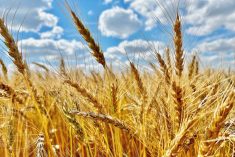WINNIPEG — Statistics Canada released its Canadian stocks estimates as of Dec. 31, 2014, and the report was mostly bearish for canola.
The canola stocks figure, at 11.103 million tonnes, was at the high end of expectations, surpassing what some people were anticipating.
“I’m not sure if that means that StatsCan’s production number for 2014 is understated, and it’s bigger than 15.56 million tonnes,” said Mike Jubinville of ProFarmer Canada.
“Or the demand element for the first five months of the marketing year was not quite as strong as expected.”
Read Also

Ample supplies and improved livestock sector to boost Canadian feed sector: FCC
Abundant feed grain supplies and improved profitability for the livestock sector should support strong feed demand and sales through the winter, says a new report from Farm Credit Canada.
The ICE Futures Canada canola market initially moved lower in reaction to the report, as it means ending stocks for canola could increase from previous estimates.
However, macro issues, such as outside oilseeds and currency movement, will continue to be the main drivers going forward, Jubinville added.
The report was also bearish for flaxseed, oats and barley because the stocks estimates were all at the top end or above pre-report guesses.
“It could be suggesting that more feed wheat is being substituted for barley in terms of the usage side of things. Or maybe the barley (production) number is also understated,” Jubinville added.
The report showed animal feed, waste and dockage usage for barley was at 2.67 million tonnes as of Dec. 31, down sharply from a year ago when 3.57 million tonnes were used. This suggests that Statistics Canada’s production figure of 7.12 million tonnes of barley for 2014-15 is too low, according to Jerry Klassen, manager of Swiss-based GAP SA Grains and Products in Winnipeg.
Total wheat stocks, at 24.818 million tonnes, were at the lower end of expectations. However, it won’t likely impact prices because it doesn’t make a big difference to the broader wheat market, Jubinville said.
Wheat stocks, excluding durum, were fairly large at 20.76 million tonnes because feed usage dropped significantly as well. Animal feed usage was estimated at 1.96 million tonnes from 2.99 million tonnes in 2013. Klassen believes this also means StatsCan’s wheat production figure of 24.09 million tonnes is understated.
The one bright spot in the report is the pulses, such as peas and lentils. The two crops had very good usage through the first five months of the crop year, which will likely lead to very tight stocks.
“The pulses look like they’re on track to going to zero for ending stocks this year,” Jubinville added.
StatsCan showed Dec. 31, 2014, stocks of lentils at 755,000 tonnes, which compares with 1.45 million tonnes the previous year. Pea stocks were at 1.56 million tonnes, down from 2.34 million in 2013.
The following table is a recap of Statistics Canada’s stocks report for the period ended Dec. 31, 2014. Figures are in million tonnes.
Pre-Report Total Stocks Total Stocks
Estimates Dec 31/14 Dec 31/13
All wheat 24.728 – 28.358 24.818 28.680
Durum 4.126 – 4.200 4.059 5.239
Canola 9.633 – 11.242 11.103 12.421
Barley 4.106 – 4.785 5.382 6.750
Flaxseed 0.553 – 0.600 0.608 0.490
Oats 1.925 – 2.534 2.485 2.848
















